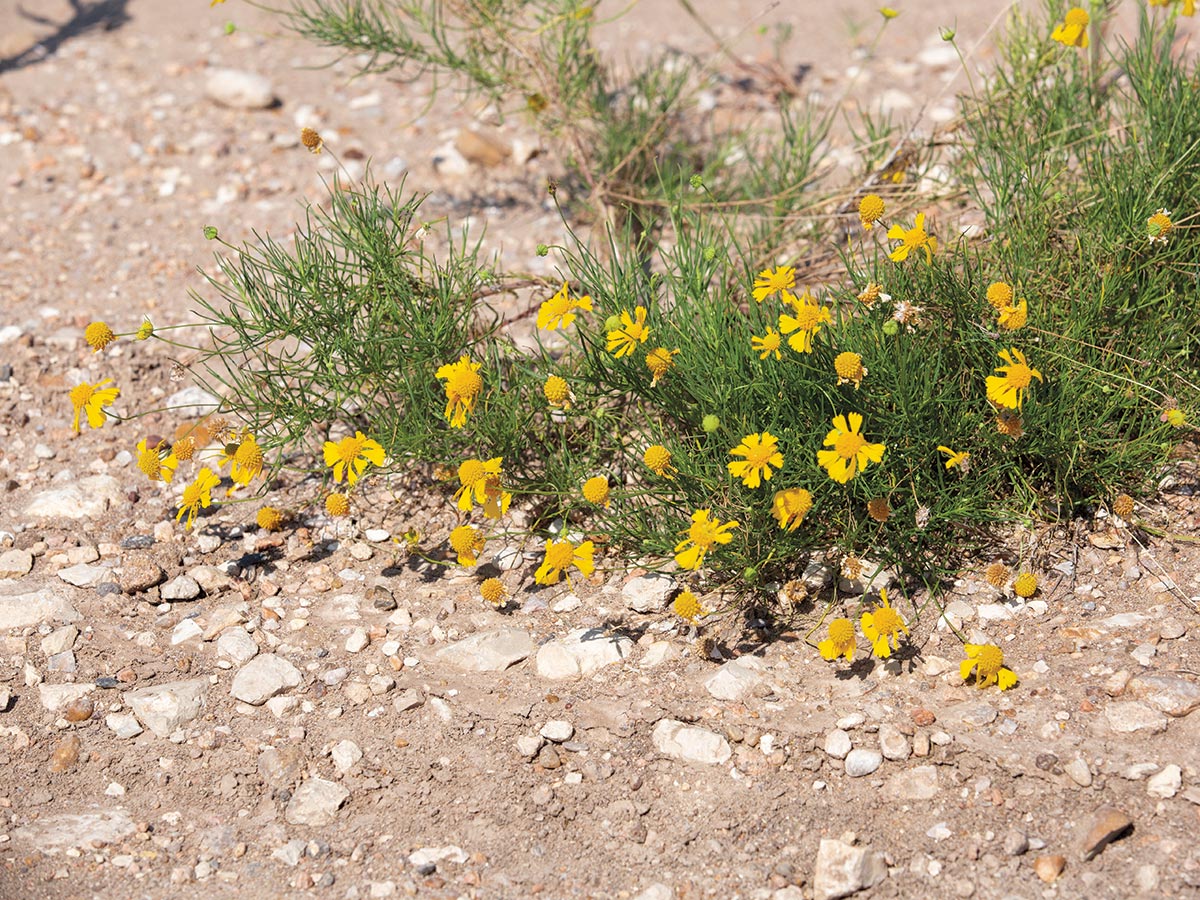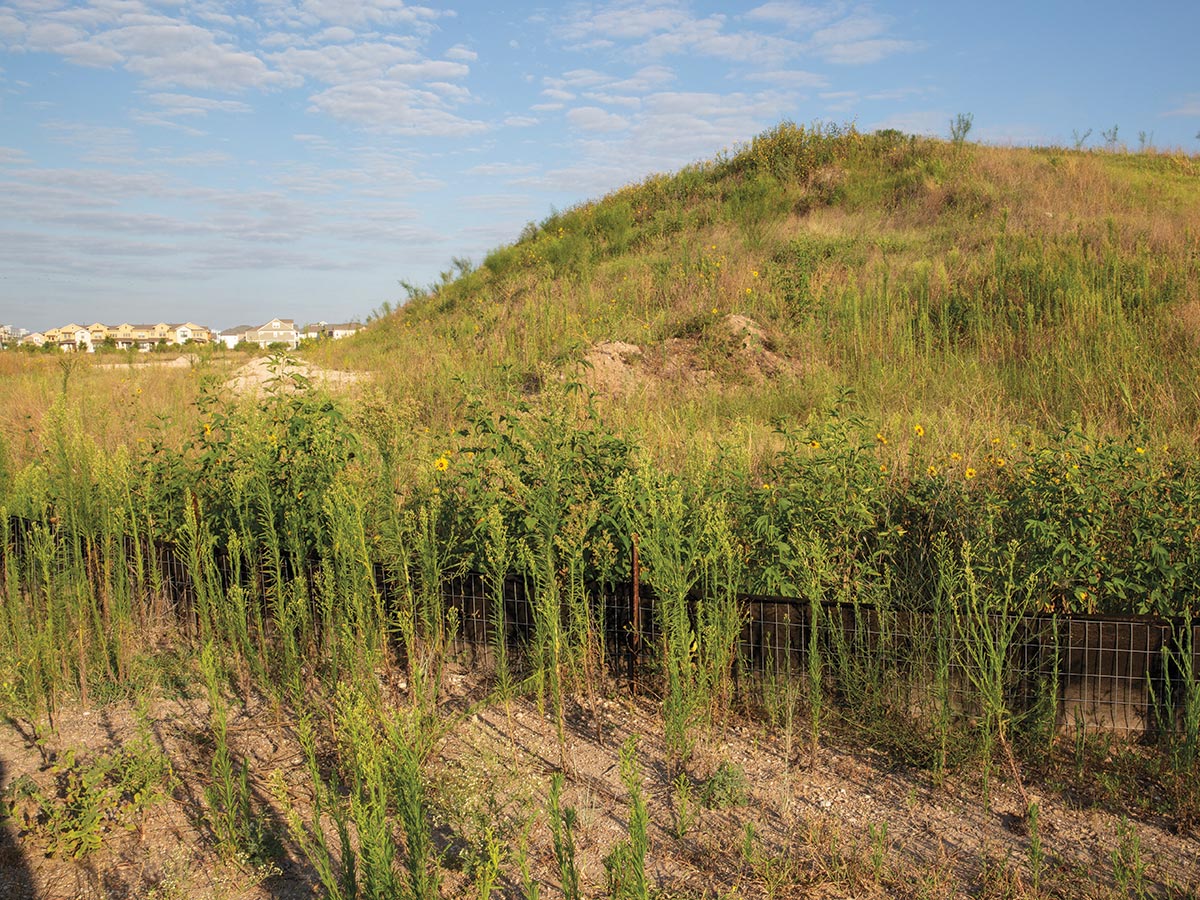Developmental Danger
On the edge of a bustling development in Central Austin, a large, empty field awaits the next round of construction. An enormous mound of dirt dominates its center, surrounded by a patchwork of packed, bare soil and riotous plant growth. The plants represent a mix of natives such as prairie verbena (Glandularia bipinnatifida), coreopsis (Coreopsis sp.), common sunflower (Helianthus annuus), yellow sneezeweed (Helenium amarum) and horsemint (Monarda citriodora) — along with non-native false ragweed (Parthenium hysterophorus) and invasives including Johnsongrass (Sorghum halepense), King Ranch bluestem (Bothriochloa ischaemum var. songarica) and Bermudagrass (Cynodon dactylon).
The field provides a good sampling of pioneer species: plants that appear after a disturbance, or an intense, short-lived environmental stress that changes the affected ecosystem. In this case — and many others like it in urban areas — humans caused the disturbance by moving and altering soil. You have likely seen similar landscapes in your own city. This kind of disturbance often reduces biodiversity and, unfortunately, is a hallmark of urbanization.
In contrast, natural disturbances increase biological diversity in ecosystems. Many plant species evolved with wildfire and flooding, as well as high-intensity, low-frequency grazing by nomadic animals. Shade-intolerant plants, for example, need disturbances to open up space; that space allows sun in and helps them get established. Natural disturbance events played a major role in grasslands that once covered this part of Texas, says John Hart Asher, senior environmental designer at the Wildflower Center.

Drought-tolerant native yellow sneezeweed does well in disturbed, calcareous soil. PHOTO John W. Clark
Once a disturbance event ends, a process known as succession begins. Succession refers to shifts in the presence and relative abundance of different species over time, whether months or centuries. The first plants to arrive are the pioneers. In urban areas — such as our in-flux development site — not all of these will be native. “A disturbed site responds to what is going on around it,” says Asher. “The resulting ecosystem depends on soil conditions, climate, how surrounding vegetation disperses its seeds, and competition.”
Soil consists of far more than dirt; healthy soil has a mix of bacteria, fungi, protozoa and nematodes. These microorganisms play critical roles in soil function and affect re-establishment following disturbance of any variety, be it fire (wild or prescribed), road construction, or clearing space for a mixed-use development.
Some plants can grow in soil with limited microbial life; in the case of our example field, this includes natives such as firewheels (Gaillardia pulchella) and bluebonnets (Lupinus texensis), as well as invasive bastard cabbage (Rapistrum rugosum). These pioneers alter the soil and ultimately determine which later arrivals succeed and which don’t.
Wind and birds or other animals serve as primary vehicles for seed dispersal. How particular plants disperse their seeds plays an outsized role in a disturbed urban area because of the likely presence of introduced and non-native plants nearby. This is one aspect of a development-caused disturbance that’s different from a natural disturbance such as fire — and why they often are damaging rather than beneficial. Seeds may even come in with dirt when earth is moved around for construction. Some seeds can lie dormant for a surprisingly long time.

Aggressive native pioneer species annual horseweed (Conyza canadensis) thrives on bare soil and is one of few native species that can coexist with invasive Johnsongrass, to the exclusion of hundreds of other native annuals and perennials that could thrive here. PHOTO John W. Clark
Competition becomes a particular issue in urban areas due to the abundance of non-native plant species. Because these species didn’t evolve over time in their current environment, they may be less susceptible to factors that naturally limit natives, such as pests and herbivores. According to Asher, “Another big factor of their success is shorter flowering and seed-production times — and more rapid growth.”
One invasive that easily outcompetes local natives is Johnsongrass, native to the Mediterranean. Its seeds can remain viable for 20 years and disperse great distances via wind, water and animals, and they can survive ingestion by birds and mammals. Johnsongrass also reproduces by rhizomes, or horizontal underground stems; one plant can spread 200 feet, and new stands are readily established. Asher says Johnsongrass also “hijacks the soil, preventing microbial development and creating a system that favors pioneer species.” It and another common invasive, King Ranch bluestem, create monocultures that degrade natural ecosystems and reduce the diversity of insects, birds and rodents as a result.
To the untrained eye, our Austin field looks healthy, even beautiful, with its sunflower blooms, waving grasses, and presence of birds and insects — certainly preferable to bare ground from an aesthetic standpoint. But the non-native species growing here can crank out seeds, increasing the range of their invasion. The birds and insects present show little diversity. If the site is left alone, natives could lose out as the plant community transitions to mostly non-native and invasive species.
When it is time to build here, the developers may scrape away the plants and invest significant labor and money in landscaping the site. But preparatory work early on — amending the soils, treating invasive plants, seeding the disturbed ground with native species, and conducting prescribed burns, for example — would be “less labor intensive and less expensive,” says Asher. Ultimately, such development sites beg a closer look, because “empty” fields are actually far from empty. They could be the loss of native habitat in action.
Melissa Gaskill writes about science, nature and the environment for a variety of publications, including Mental Floss, Newsweek, Men’s Journal and Alert Diver; her books include “A Worldwide Travel Guide to Sea Turtles” and “Best Hikes with Dogs: Texas Hill Country and Gulf Coast.”.

